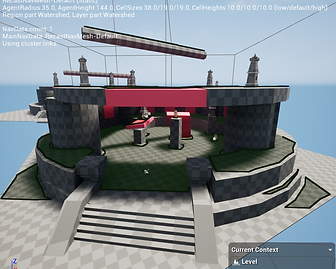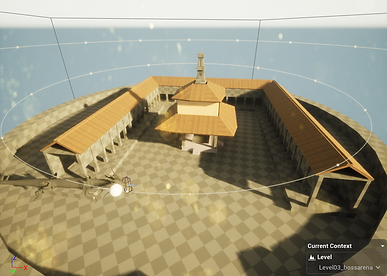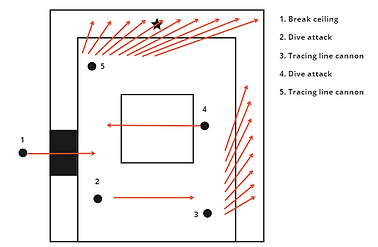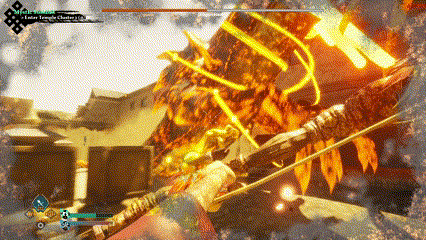Quest Designer & Level Designer
Asurya's Embers
Unreal Engine 5 | 22 Developers | 3 months
Summary

Asurya's Embers is a first-person, bow-and-arrow shooter game. The Player plays an archer who thrives in the shadows. They defeat enemies and solve environmental puzzles by using the sunlight and the shadows that are being cast onto the world by the sunlight.
Genre: FPS
Engine: Unreal
Platform: PC
Team Size: 22 Developers
Development Time: 3 months
Role & Responsibilities
Combat design
-
Enemy design
-
Boss design
-
Enemy placement (Partially)
-
Boss arena design
-
Tuning
Gallery
Design Thoughts
Starting from the functionality
For the enemy design, I begin by considering the player's skills that each enemy can test. I aim for diversity, gradually increasing the difficulty. For instance, the first enemy should remain relatively still, providing the player with a wide time window to practice shooting. The second enemy will have higher mobility, requiring the player to shoot a moving target. The third enemy will only open the attack time window for a brief period, prompting the player to learn attack timing.

Giving them different roles
Another important aspect is to assign different roles to the enemies so that they can create powerful combinations when grouped together.

Aligning their feature to their contexts
Given that our game is set in Nepal, we conducted research and selected certain animals to serve as enemies. Taking the art workload into consideration, we decided to reuse some of the models.

Enhance the shadow & light gameplay mechanic
Because we have the light & shadow gameplay mechanic, we want to also apply this feature to the enemies, so we add light sources onto the enemies and also make them their weak points. This not only make them consistent in appearance but also add another layer of strategy. If the player shoot the light source while the enemy is in shadow area, they will stun. Also shooting the light source will cause better damage. Sadly, due to lack of time, this design is not implemented to the final game.

Interesting enemy scenarios
When the enemy design was initially introduced, our level designers were uncertain about how to incorporate them into their levels. I drew various scenarios as suggestions. I considered what environments (in our game, primarily terrains with different heights) could be interesting and what combinations of enemies could create engaging scenarios.

Design example of one enemy



Boss Design
I designed a two-headed dragon-serpent boss for our game. Initially, our hero used a dragon head bow, and our artist experimented with a dragon flying sequence in Unreal. So, I thought I could create a dragon-type enemy in our game, and I believed a dragon with two heads would be cool. However, considering we already had three dragon heads in total, I decided to change one of them to be a serpent head, resulting in the dragon resembling a cat-dog.
Our game designer also added context to connect the dragon boss with the dragon bow narrative-wise. Originally, it was a two-headed dragon, and one of them becomes the bow held by the player. The serpent lures the other dragon, and things become uncontrollable.
To create a dragon boss is not easy, so I suggested we use it twice, making it the boss for both level 2 and level 3. The boss arena for level 2 is a cave-based environment, while level 3 is a more open area. I proposed having the dragon dig into the cave and attack the player as a half-body in level 2, and then having it appear as a whole in level 3.
In the cave of level 2, the dragon head will attack from the ceiling, creating holes that allow sunlight to shine in, dynamically changing the environment with varying light and shadow effects. Simultaneously, the serpet head will attack from the ground, leaving impassable holes that gradually limit the player's mobility. Eventually, they coordinate their attacks, executing combo moves to increase the overall challenge.
In level 3, the environment opens up, and the two-headed boss takes to the sky above the buildings. Players can seek refuge beneath the ring-shaped ceiling to avoid sunlight, but the dragon will penetrate various parts of the ceiling to break it, employing the same attack techniques to target the player.
In phase two, the boss will summon minions and adopt a more defensive stance. To defeat the boss, the player needs to stun it during phase two and then traverse its body as a bridge to reach the other end. The player must use melee attacks to break its light source core in its mouth three times.







Boss arena design
Initially, the arena I designed for the dragon boss was round (as you can see in my draft). The purpose was to ensure the player had an equal distance when facing the dragon for attacks. However, based on our research, we found that most similar architectural structures in Nepal are rectangular. Therefore, I adapted the shape to better fit the context.
From round shape
To rectangular shape


To keep the impact of the dragon who can bring a dynamic environment, the newly added roof need to be destruct after the dragon strike. I checked with our programmer who said no problem and then we implemented it together.
For the AI of the dragon boss, I designed its attack pattern, which includes three main skills: (melee) Dive Attack and (ranged) Tracing Line Cannon (Dynamic change of environment) Break Ceiling. Considering the layout of the arena, I planned three attack patterns, utilizing different skills at various positions to engage the player. To enhance the dragon's intelligence, I also incorporated triggers to make the dragon occasionally aware of the player's position. Simply having the player reach a specific point and the dragon instantly attacking there can make the encounter seem more vivid.

A example of an attack pattern
Dragon boss final outcome

Retrospective
WHAT WENT WELL
-
The enemies are designed as different roles and can be combined together to set different encounters.
-
Have a eastern dragon boss in the game is cool and suit the game's narrative.
-
The AI behavior tree helps the programmer to implement the enemies more efficiently.
WHAT COULD
BE BETTER
-
The Toady is too difficult in AI that it's hard to implement it good.
-
The intial dragon boss design it too complex and the second level and third level's design can even be counted as two different ones.
-
Enemies' design are not align with the player character's ability, which makes the ability not very effective.
WHAT
I
LEARNED
-
Each enemy only need to do one thing good.
-
Keep scope in mind - Try to reuse assets and mechanics as possible.
-
The player abitliy's design should cooperate closely with the enemy's design.





